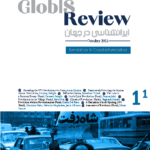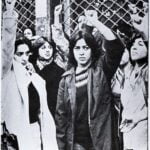Rereading the 1979 Revolution over Time (©Background)
Re-reading the Iranian Revolution over Time, by Azam Khatam

The Iranian 1979 revolution has been a central focus of academic research at universities across the globe and a key topic of political science publications inside Iran. The Islamic revolution was an unexpected occurrence for many since, in the late 1970s, Iran benefited from a strong economy with a robust affluent middle class and a political system backed by a large army, an operational bureaucracy, and powerful foreign allies. The unexpectedness of the revolution fueled much scholarly interest to examine its complexities in the 1980s and 1990s. However, this scholarly interest waned over time, particularly inside the country, where the 1980s cultural revolution undermined the prospects for independent research in the field and state-sponsored institutions monopolized the research and publication on the subject.
In 2022, in the midst of the Woman, Life, Freedom movement, large sections of the youth called for another revolution in Iran, seeking radical political change and imaginings of a different future. This transition from rejecting to now embracing the revolutionary mindset among many Iranians raises critical questions like what the younger generation’s perception of a revolution is and how they differentiate it from the 1979 revolution. Do they reject the 1979 revolution, for the political regime it gave rise to, or for the one it opposed? This paper examines the debates surrounding the 1979 revolution by introducing its seminal books, assuming that the current moment is one of growing interest in contentious politics. It also invites readers to actively engage with this scholarship in light of questions regarding the future of politics in Iran.
While there are many scholarly articles that review the most cited English-language books on the 1979 Iranian revolution, reviews of Persian-language books are limited, making it difficult to have a general view of the most influential texts in this large scholarship.[1]For a brief English overview of some of the important books authored by Islamists, or as she refers to them,nihzat scholars on the subject, have a look at Sohrabi 2018. To examine the English scholarship, I have selected seven review articles, all written by experts in the field and cover a total of twenty books published over forty years. These books have viewed the 1979 revolution through various lenses and focused on one of the four major characteristics of the revolution: the ideological resurgence of “Muslim identity” against Western political and cultural penetration; the conflict between classes driven by uneven capitalist development and political autocracy; the rise of alternative Islamic modernity against colonial modernity; and a popular revolutionary movement with enormous impacts on ordinarypeople’ss lives. We return to these perspectives and their arguments later in this paper.
The “one-way street” of the Iranian Revolution
In her review article, historian Naghmeh Sohrabi divides the historiography of the revolution into books published in Iran and those published outside of Iran, a division based on the geography of knowledge production. She describes the relationship between these two academies as a “one-way street” in which works published outside are translated and made available for researchers in Iran but that the vast majority of scholarly works published in Iran have remained available only in Persian. (Sohrabi, 2018: 6) Naturally the number of books published outside of Iran compared to the huge number of books published inside the country is small, however it is difficult to draw a distinction between academic and non-academic works as academic reviews of Persian scholarship are rare or nonexistent.
It is estimated that approximately one hundred to two hundred titles make up the central bibliography of books published on the Iranian revolution in the English language, a number that is expectedly much lower than books published inside Iran. A bibiliography on the subject was released by Iran Book House’s history journal, showing on average, 65 books were published each year in the 2000s under the heading of the “Islamic revolution.” (Sheida Saberi, 2008) Books explaining Khomeini’s doctrine and teachings, biographies of revolutionary figures, uncovered documents from Iran’s intelligence and security service (SAVAK), revolutionary diaries and memoirs, and books on Iran’s politics in the 1970s are all included in this. The non-ideologically aligned academics would not engage in research about the 1979 revolution while holding a position at university; they would avoid the disputes it may raise with common stereotypes promoted by authorities. Hossein Bashiriyeh, is one of them who taught political sociology at Iranian universities in the 1980s and 1990s. Although he wrote books on theories of revolution, his 1984 English book on the analysis of the Iranian revolution was not translated into Persian until 2019.[2]Bashiriyeh’s discussions of the transition to democracy sparked a great deal of interest among university students, especially during the reform era, and his reformist students later called him … Continue reading
There are very few academic books about the 1979 revolution that are based on field research; the majority were written by scholars and doctorate candidates who came from outside in the early 1980s (including Hoogland, 1982/1380; Hegland, 2014/1393; Bayat, 1987/1400; 1997/1391). The local diaries and histories that need to be carefully framed and examined are not included in these books. In recent years, younger scholars have demonstrated an interest in deconstructing the official, monolithic account of the revolution. They have done this by looking through local histories, archives, and other resources to uncover lost stories. Ali Nikounazar’s (1398/2019) book on Cinema Rex is one of them.
Research on the 1979 Revolution at World Academies
In 1982, Fred Halliday published one of the first reviews of English academic books on the 1979 revolution. After reviewing six of the many books that were published during this brief time, he identified five key characteristics that set the Iranian revolution apart from other modern revolutions: its religious content; its ideological aspects (such as the negation of nationalism and material well-being); its overthrow of a mighty government; its urban nature; and finally an unprecedented period of turmoil, fragmentation and chaos that followed the revolution. HomayunKatouzian’ss 1981 book, one of the six books selected for this review, attempts to bridge the gap between economics and politics, but Halliday argues that aside from his complete disregard for society, Katouzian’s detailed economic analysis does not fit with his macro-political narrative of Asian despotism.[3]In his seminal book Oriental Despotism (1957), political scientist Karl Wittfogel presented a theory of ancient irrigation systems of the Middle East led to government control for ensuring proper … Continue reading
The other book reviewed by Halliday is Farhad Kazemi’s 1980 publication that highlights the role played by peripheral settlers and migrants—those who were deeply dissatisfied with their circumstances—living in Iran’s outskirts, during the revolution. Halliday was also drawn to Shahrough Akhavi’s 1980 book on the relationship between the clergy and government. Akhavi argues that while it is true that Sunni clergy are entitled to state funding, Shi’ite clergy in Iran is primarily supported by donations from the faithful, resulting in greater supposed independence from the state. However, such independence does not increase the Shi’ite ulema’s oppositional tendencies with the state. There are conflicting ideas about the state-clergy relation among different schools in Shi’ii Islam. Khomeini’s rise to leadership reflects his own theory of clerical political activity, and eventual hegemony over the revolution. Michael Fischer’s 1980 book on Qom seminaries in the 1970s, according to Halliday supports Akhavi’s viewpoint. Fischer also believes that seminaries were in conflict with the secular government only in the years preceding the revolution. Yet, he suggests that Shi’ite mythology, particularly the ritual of martyrdom and the fight against evil played a significant role in popular mobilization during the 1979 revolution. Finally, Halliday talks about two books: Answer to History by Mohammad Reza Pahlavi and the 1980 book by Fereidun Hoveyda. Fereidun was the brother of Amir Abbas Hoveyda, the longest serving Prime Minister of the Shah. Halliday points out that both books demonstrate the Shah’s incapacity and political blindness, and that his political ignorance played a role in his ultimate overthrow.
In 1984, Mahmood Yousefi wrote another review article examining six books published on the Iranian revolution, three of which were among those chosen by Halliday in his review (Akhavi, 1980; Katouzian, 1981; and Kazemi, 1980); while the remaining three included Ervand Abrahamian and EricHoogland’ss books, both published in 1982, and BijanJazani’ss 1979 book. Yousefi argues that the authors of these books generally refer to rapid secularization, the contradictions of a dependent capitalist system, and the intentional undermining of the power of the clergy, as three main factors that broadened the popular base of the revolutionary forces in the 1970s. Hoogland and Kazemi also emphasize the role of dissatisfied poor rural migrants in the revolution, given the fact that they did not receive agricultural land in the 1963 Land Reform, and were pushed to cities and settled in the urban outskirts. In this argument, Yousefi argues that Hoogland and Kazemi however fail to provide sufficient evidence that dwellers of urban outskirts played a significant role in the revolution. Yousefi also notes that Katouzian’s emphasis on oil tyranny cannot explain the revolution because Reza Shah’s government was also a type of oil tyranny.
According to Yousefi, Abrahamian’s theory of imbalanced development aptly illuminates the prerevolution conditions: “The gulf between the developing socioeconomic system and the underdeveloped political system had become so wide that an economic crisis was able to bring down the whole system” (p.348) He also findsAkhavi’ss study on clergy-state relations an essential contribution as it explains how the rapid secularization of state under the Pahlavi increased hostile attitudes toward the state among Ulama. Yousefi highlights the importance of revolutionaries’ search for social justice, opposition to despotism, and resistance to the state’s extreme secularization as he wraps up his review. (p. 351)
Ten years after the revolution, in 1989, Shahrough Akhavi wrote another article review on two new books by Said Amir Arjomand (1988) and Mohsen Milani (1988) arguing that many aspects of the revolution have been thoroughly studied and researchers are now more concerned with its ideology and leadership: We “know well who participated in this revolution and what were the preconditions, the stages, the role of ideology, the role of individuals, the nature of the state collapse, and the consequences of the revolution within Iran” He continues:
Consensus is lacking over the relative importance of middle class and religious elements in fall 1978-winter 1979 in explaining the February 1979 seizure of power. We have less definitive information about the dynamics of coalitions, the significance of class as a variable, the mobilization of resources at specific crucial junctures, … and the significance of the American role. (Akhavi, 1989: 292)
These two books were important to Shahrough Akhavi because they dealt with the role of the clergy as well as the fragility of the Shah’s regime. By concentrating on the history of state-building in Iran, Amir Arjomand holds that the clergy had doctrinally and in practice remained subordinated to the state, though only in matters of political authority and power. Akhavi argues that the gem of AmirArjomand’ss book is his discussion of changes in the theory of authority inShi’aa law in chapter 9, where he suggests the ulema were entitled to residual velayat only, according to the Usuli doctrine, and they could not compete with state for political power. It was only in the 19th century that the clergy began to challenge the state’s role in the political arena when they joined the civil society in the Constitutional Revolution of 1905-1909, to protest against the state.
The combination of revolutionary forces is thoroughly examined by Milani, who demonstrates that even the capitalist class was against the government’s intervention in the private sector. He also looks at the tense Shah-US relations in the 1970s which contributed to the regime’s fragility.
In 1992, Charles Tilly wrote an article, reviewing two comparative studies of some of the key 20th century revolutions: one by Jack Goldstone et al. (1992) and the other by Tim McDaniel (1991).McDaniel’s book also deals with the 1979 revolution in Iran. Tilly writes on the importance of these comparative studies:
Under the impact of the world’s enormously varied violent transfers of state power since 1945, political analysts are finally relinquishing an old illusion, namely, that revolutions are singular phenomena for which it is possible to state a single invariant set of necessary conditions, sufficient conditions, and internal sequences. As with the abandonment of many old, cherished beliefs, the new apostates are not always aware of how heterodox they have become; and those who do know often only whisper their unbelief. (Tilly, 1992: 1084)
In Tilly’s opinion, these two books try to move beyond classical sociology and see the revolution as an unpredictable and varied event, but ultimately fail to achieve this objective in their books. As an example, McDaniel’s analysis of authoritarian and top-down modernization in Russia and Iran – which led to industrial prosperity, albeit with the arbitrary intervention of the Tsar or the Shah in economic affairs – repeats almost the same analytical pattern of the classic revolutions. Although Tilly finds Goldstone et al.’s focus on how the Cold War and the changing international environment transformed the revolutions that unfolded in the ten global cases they studied illuminating; but finds their emphasis on the three stages of a revolution – including the emergence of a crisis in governance, the struggle for power, and the establishment of a new government—as having missed the role of international powers and the Cold War situation that supported the emergence of a form of nationalism in revolutions. “Moreover, they insist that no revolutionary crisis occurs until there is a conjunction of three necessary conditions: a crisis in the old state, alienation of a significant segment of the elite [from the state], and mass mobilization.”
In 1995, Misagh Parsa critically reviewed four new books that mainly dealt with the 1979 revolution’s ideological backings. According to Parsa, the majority of scholars who have focused on the significance of religious ideology in the 1979 Iranian revolution have not been able to show how it affected the process of public mobilization prior to the revolution’s victory. He believes that most of these researchers view the revolution in retrospect, starting with the establishment of the Islamic Republic. One of them is John Foran (1993), who asserts that the revolution’s leaders did not aim to establish a religious government even though he acknowledges the importance of the clergy and the autonomous network of mosques to the revolution’s success. Mansoor Moaddel (1993) provides another example. According to Moaddel, the rise of Islamic ideology can be attributed to the secular ideas’ decline in the post-1953 coup era and the clergy’s convergence with anti-Western and those classes who were not benefiting from Pahlavi’s development plans. Parsa claims that ideology is only an addition to class analysis in Moaddel’s argument.
Another book that Parsa reviews is Hamid Dabashi’s 1993 publication. Even though Dabashi starts his investigation with Islamic scholars of the Pahlavi era and shows how their ideas influenced the formation of the Islamic Republic, Parsa believes that he ignores the fact that these ideas contribution to the formation of the incoming government does not justify their role in popular mobilization for the revolution. Parsa concludes by analyzing Abrahamian’s 1982 book on Khomeinism. According to Abrahamian, Khomeini was a populist rather than a fundamentalist. Unlike fundamentalists Khomeini focused on the “oppressed” and like other populists he prioritized political and cultural reconstruction rather than social and economic revolution. Parsa notes that Abrahamian’s conception of “Khomeinism” greatly influenced the debates on the role of ideology in the 1979 revolution.
Also in 1995, Mahmood Monshipour published a review on John Foran (1993) and Hamid Dabashi (1993) books, raising the question of whether studying the ideology of a revolution was more important than the study of other factors. Monshipour points out that in the Middle East, unlike the industrialized Asian countries, the state’s legitimacy relies on its ideological influence rather than its achievements in economy and development. However, this does not mean the focus on ideology would be enough for an analysis of a revolution. Dabashi’s book examines Islamic values and beliefs by studying Islamic intellectuals as well as members of the public. Monshipour draws a comparison between Dabashi’s book and Foran’s work, which attempts to offer an economic analysis of the 1979 revolution with no reference to its ideology. He suggests that neither approach is sufficient and it would be better to view the two books as complementary.
Among more recent reviews on the 1979 revolution, Naghmeh Sohrabi’s 2018 work, spanning four decades of research, stands out. Sohrabi highlights that many scholars lack sufficient access to the historiography of the revolution in Iran, while histography of the revolution outside the country is largely skewed because it is written by a generation of academics who have personally experienced the revolution in some form and the post‐revolutionary events fundamentally altered their lives. For these scholars, “tragedy” remains the main employment of the revolution’s story. The intellectual turmoil of the 1970s, which shows itself in the blending of Islamist, socialist, and secularist ideas in a post-colonial world where the revolution itself was born has not been seriously taken into consideration in their analysis. She maintains that revolution historiography in Iran harbors a desire for a total revolution but the same yearning also haunts the exiled academics working on the topic to make sense of why decades of struggle resulted in defeat/tragedy. (p. 4)
Michel Foucault’s writings about the 1979 revolution further contribute to the lasting interest and debate among academics studying the subject, particularly from the framework of the conflict between two normative and non-normative perspectives on the revolution. Foucault traveled to Iran twice in 1978, and described the revolution as he saw it on the streets, largely as spiritual politics and a political will to fundamentally break with the Western as well as the Eastern Bloc’s social and cultural systems. His writings attracted a lot of controversy at the time, and some Iranian and French intellectuals debated and publicly criticized him in the media. His book, What Are the Iranians Dreaming About? was translated the same year and added to all reference lists on the 1979 Iranian revolution. Janet Afari and Kevin Anderson’s book (2005) critically examined Foucault’s writings and debates from a gendered lens and provided an English translation of some of the philosopher’s debates with others throughout the years. Afari and Anderson argue that Foucault was captivated by the Islamists’ ability to inspire millions of people through religious symbols, leading him to disregard the potential risks associated with their leadership in a revolution that also ignored the warnings of feminists. Furthermore, they imply that Foucault overlooked the reality that women and children made up the majority of the victims of the premodern order because of his harsh criticism of modernity. In 2016, Behrooz Ghamari-Tabrizi published his book Foucault and the Iranian Revolution, which could be considered a response to Afari and Anderson. In affirmation of Foucault’s key concepts, Ghamari-Tabrizi argues that the revolution in Iran was replete with possibilities and nobody could see its future at the moment.
This paper used the perspectives of seven reviewers to examine the central questions and main arguments put forth by the authors of twenty books on the Iranian revolution of 1979. We note the articulation of the questions and debates changed over time in response to new research and shifting academic paradigms in the field. This review suggests that the changes in how the authors have articulated their claims about the revolution are not significantly affected by new field research or books examining the local histories of the revolution. Due to the government’s monopoly on the field, independent and critical research is difficult to conduct and theorists are deprived of the richness that comes from documenting the experiences of various local and social groups during the revolution. However, as the 2022 Women, Life, Freedom movement showed, the 1979 revolution remains vivid in Iranians’ collective memory. Young people, with no personal or immediate knowledge of the incident, recounted it in their own ways and called yet for another revolution to change the political regime in Iran. It is hoped that this paper will encourage further research on the diversity and multiplicity of the lived experiences of the 1979 revolution.
References
Abrahamian, Ervand. 1982. Iran Between Two Revolutions. Princeton: Princeton University Press, 1982
———–1993. Khomeinism: Essays on the Islamic Republic. Berkeley: University of California Press
Afary, Janet and Kevin B. Anderson. 2005. Foucault, Gender, and the Iranian Revolution: The Seductions of Islamism. Chicago: University of Chicago Press
Akhavi, Shahrough. 1980. Religion and Politics in Contemporary Iran. Albany: State University of New York Press
———–1989. “Reflections on a Decade of Scholarship on the Iranian Revolution: Background to Two Recent Perspectives in the Literature.” Middle East Journal, 43 (2): 289-295
Alavi, Yaqob, 2005/1384. “Books on Revolution: An introduction to the Islamic Revolution bibliography [Ketābhāy-e enghelāb: moghadameiy bar ketābshenāsy-e enghelāb-e eslāmy].” Zamāneh, 41&42: 57-62
Amir Arjomand, Said. 1988. The Turban For The Crown: The Islamic Revolution in Iran. New York and Oxford: Oxford University Press
Babavand, Hamid. 2003/1382. “New Books 2002: Related books on the revolution and Islamic Republic [Tāzehāy-e nashr 1381: ketābhāy-e mortabet bā enghelāb va jomhury-e eslāmy].” Andisheye Enghelābe Eslāmy, 5:163-218
Bashiriyeh, Hossein. 2011. The State and Revolution in Iran- 1962-82. London: Routledge
Bayat, Asef, 1997. Street Politics: Poor People’s Movements in Iran. Columbia University Press.
————1987. Workers and Revolution in Iran, A Third World Experience of Workers’ Control. Zed Books.
Dabashi, Hamid. 1993. Theology of Discontent: The Ideological Foundations of the Islamic Revolution in Iran. New York: New York University Press
Fischer, Michael. M. 1980. Iran: From Religious Dispute to Revolution. Cambridge, MA: Harvard University Press
Foran, John, 1993. Fragile Resistance: Social Transformation in Iran from 1500 to the Revolution. Boulder, CO: Westview Press
Goldstone, Jack, Ted Robert Gurr, and Farrokh Moshiri. 1992. Revolutions of the Late Twentieth Century. Boulder: Westview
Halliday, Fred. 1982. “The Iranian Revolution.” Political Studies, 30(3): 437-444
Hegland, Mary Elaine. 2014. Days of Revolution: Political Unrest in an Iranian Village. Stanford, Calif.: Standard University Press
Hoogland, Eric.1982. Land Reform and Revolution in Iran, 1960-1980. Austin: University of Texas Press
Hoveida, Fereidun. 1980. The Fall of the Shah. London: Weidenfeld and Nicolson
Kazemi, Farhad. 1980. Poverty and Revolution in Iran: The Migrant Poor, Urban Marginality and Politics. New York: New York University Press
Katouzian, Homa. 1981. The Political Economy of Modern Iran: Despotism and Pseudo Modernism, 1926-79. New York: New York University Press
Keshavarzian, Arang, & Ali Mirsepassi (Eds.). (2021). Global 1979: Geographies and Histories of the Iranian Revolution (Vol. 18). Cambridge University Press
McDaniel, Tim. 1991. Autocracy, Modernization, and Revolution in Russia and Iran. Princeton: Princeton University Press
Milani, Mohsen. 1988. The Making of Iran’s Islamic Revolution: From Monarchy to Islamic Republic. Boulder, CO: Westview Press
Moaddel, Mansoor. 1993. Class, Politics, and Ideology in the Iranian Revolution. New York: Columbia University Press
Nikunazar, Karim. 2020/1399. Sinamā Jahanam: Shesh Gozāresh Darbāreh’ Ātashsuzy dar Sinamā Reks [Hell Cinema: Six Reports on Human Incineration at Cinema Rex]. Tehran: Cheshmeh Publishing House
Parsa, Misagh. 1995. “Review: Ideology and Revolution in Iran.” Middle East Report, 196:30-32
Saberi, Sheida. 2006/1387. “The bibliographic index of the history of the Islamic Revolution.” (Namaieh manba’-shenasi-e Tarikh enqelāb eslāmy). Ketab-e Māh-e Tārikh va Geographia, 129:118-127
Sohrabi, Naghmeh. 2018. “The ‘problem space’ of the historiography of the 1979 Iranian Revolution.” History Compass, 16(11): e12500
Tilly, Charles. 1992. “Book Review.” American Political Science Review, 86 (4): 1084-1085.
Yousefi, Mahmood. 1984. “Dimensions of the Iranian Revolution: A Review Essay.” Western Political Quarterly, 37(2): 343-352
©Background Image in Home Page: By Unknown Author – taghribnews.com، Public Domain، Wikipedia![]()
Endnotes
| ↑1 | For a brief English overview of some of the important books authored by Islamists, or as she refers to them,nihzat scholars on the subject, have a look at Sohrabi 2018. |
|---|---|
| ↑2 | Bashiriyeh’s discussions of the transition to democracy sparked a great deal of interest among university students, especially during the reform era, and his reformist students later called him the father of Iranian political sociology. His1984 book was translated and published in Tehran in 2019. |
| ↑3 | In his seminal book Oriental Despotism (1957), political scientist Karl Wittfogel presented a theory of ancient irrigation systems of the Middle East led to government control for ensuring proper distribution of the water. Marx developed the idea of oriental despotism into his theory of the Asiatic mode of production, in which he asserted that there was no private property but rather a despotic, centralized state that controlled indispensable public goods like irrigation. |









Comments are closed.